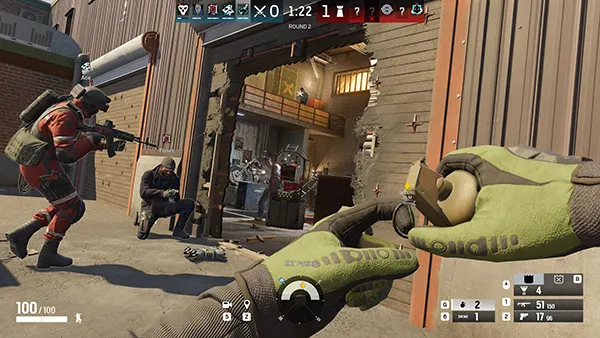Tom Clancy’s Rainbow Six Mobile — A Tactical Shooter of Serious Calibre for Smartphones
Tom Clancy’s Rainbow Six Mobile has brought one of Ubisoft’s most iconic tactical shooters to the small screen without losing its depth or realism. Released globally in 2024, this mobile adaptation combines precise gunplay, team coordination, and high-stakes strategy, making it one of the most ambitious shooters ever designed for Android and iOS. It’s not just a trimmed-down version of Rainbow Six Siege—it’s a complete, competitive experience optimised for touch controls and shorter play sessions.
The Core Gameplay Mechanics
Rainbow Six Mobile preserves the franchise’s hallmark of tactical realism. Every round revolves around coordinated assaults, defensive setups, and quick-thinking reactions. Players take on roles as Attackers or Defenders, each equipped with distinctive gadgets—from breach charges and drones to reinforced walls and surveillance cameras. The destruction system, powered by Ubisoft’s proprietary engine, remains impressive, allowing for creative entry points and unpredictable engagements.
Each operator retains their unique abilities, giving matches a distinctive flavour. Sledge, Ash, Jäger, and Bandit return with their signature gadgets, ensuring veterans feel right at home. The precision of aiming and weapon recoil has been carefully adjusted for touchscreen gameplay, resulting in a learning curve that rewards tactical awareness rather than reflexes alone.
Matchmaking times have been optimised for quick access, ensuring battles last between five and eight minutes—ideal for mobile sessions. The balance between casual play and competitive intensity makes it suitable for both veterans and newcomers to the tactical shooter genre.
Adaptation and Visual Quality
Despite hardware limitations, Rainbow Six Mobile offers detailed maps such as Bank and Border, faithfully recreated from Rainbow Six Siege. Ubisoft Montreal has optimised textures and lighting to maintain visual fidelity while ensuring smooth frame rates across modern devices. The result is a visually rich and responsive experience, even during intense firefights.
The developers have also refined the control layout. Customisable HUDs, adjustable sensitivity, and controller support enable players to adapt the interface to their play style. This attention to accessibility reflects Ubisoft’s effort to bring console-grade precision to a handheld device.
Audio remains a major tactical component. From footsteps on wooden floors to distant breaching charges, the sound design enhances situational awareness, which is vital in identifying enemy movements or predicting flanks.
Operators, Progression, and Modes
Rainbow Six Mobile introduces a structured progression system based on experience levels, operator unlocks, and seasonal events. Players can earn new operatives and skins through missions or the seasonal Battle Pass. The emphasis on fair play means that premium content remains mostly cosmetic, maintaining a balanced environment for all participants.
The main modes—Secure Area, Bomb, and Hostage—have been streamlined for shorter matches without losing strategic complexity. Teams must coordinate tactics in real time, using drones for reconnaissance and traps for defence. These modes encourage careful planning and precise execution rather than chaotic gunfights.
Ubisoft’s server infrastructure ensures global matchmaking with low latency, backed by frequent updates and anti-cheat systems. The game’s growing competitive scene already hints at future eSports potential on mobile devices.
Community and Competitive Scene
Since its full release, Rainbow Six Mobile has attracted a growing international player base. The community-driven development model allows Ubisoft to gather feedback directly from users, leading to regular balance tweaks and new content drops. Operator reworks and map rotations keep the gameplay fresh and engaging throughout each season.
Esports organisations have started hosting tournaments in collaboration with Ubisoft, with regional qualifiers paving the way for international championships. These events help establish Rainbow Six Mobile as a serious contender within the mobile competitive shooter ecosystem.
Social features, including in-game voice chat, friend lists, and squad systems, encourage cooperation. The presence of ranked ladders and stat tracking further supports a sense of achievement and progression.

Performance and Technical Aspects
Rainbow Six Mobile’s optimisation for Android and iOS ensures compatibility across a broad range of devices. The engine dynamically adjusts resolution and effects, maintaining fluid gameplay even on mid-range smartphones. Battery efficiency has been a focus, enabling long play sessions without overheating or excessive drain.
Ubisoft has also introduced cloud synchronisation, allowing players to maintain their profiles across multiple devices. Progress, unlocks, and purchases remain tied to the Ubisoft Connect account, simplifying cross-device play and ensuring data integrity.
Frequent patches and live service updates keep the title stable and secure. With constant improvements to matchmaking algorithms and frame rate stability, the mobile version continues to narrow the gap between handheld and console experiences.
Future Development and Outlook
The roadmap for 2025 promises new operators, maps, and limited-time events inspired by the Siege universe. Ubisoft aims to expand its esports integration with official tournaments and improved spectator tools. Player feedback will continue to shape the game’s balance and user interface updates.
Technological enhancements like 120Hz display support and advanced haptic feedback are also in development. These features will push mobile gaming performance to new heights, aligning Rainbow Six Mobile with next-generation standards.
With its ongoing updates, community engagement, and strategic depth, Tom Clancy’s Rainbow Six Mobile stands as one of the most polished and realistic tactical shooters available on smartphones in 2025.